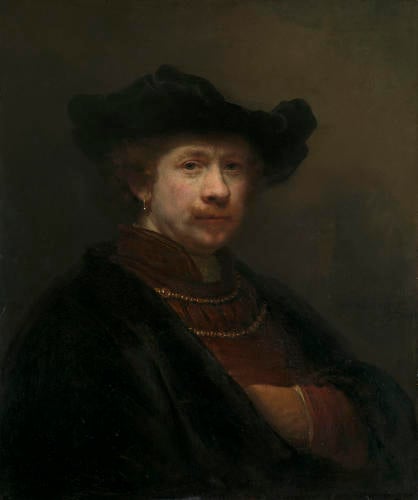-
1 of 253523 objects
Self-Portrait in a Flat Cap Signed and dated 1642
Oil on panel | 70.3 x 58.8 cm (support, canvas/panel/stretcher external) | RCIN 404120

Rembrandt van Rijn (Leiden 1606-Amsterdam 1669)
Self-Portrait in a Flat Cap Signed and dated 1642
-
It is not perhaps surprising that Rembrandt, the greatest artist of seventeenth-century Holland, should have been so self-indulgent in depicting his own likeness. Rembrandt literally paints his autobiography by means of some forty pictures, as well as thirty-one prints and numerous drawings. The earliest show him as a young man in his early twenties, the last produced in the year of his death at the age of 63. This painting shows him at the height of his success aged 36, before bankruptcy and bereavement lent his self-portraits a more melancholy air and introspective demeanour. Here he depicts himself in a direct way as a confident, successful man of the world. He exudes gravitas but is instantly likeable: his troubles have yet to overwhelm him. It was purchased in 1814 by George IV, who was a great admirer of Rembrandt and acquired three of the five paintings by the artist in the Royal Collection.
Characteristic of Rembrandt's serial self-portraiture is an unflinching - and sometimes unflattering - examination of his appearance and how it changes with age, wrinkles and sagging folds of skin being portrayed with as much attention as the lustre of a pearl or the tactility of velvet. The facial physiognomy here fits between that of the slightly younger Rembrandt in the Self-Portrait of 1640 (National Gallery, London) and that in the Karlsruhe, which is generally dated c.1645. As in many of his self-portraits, he does not wear contemporary fashions of his own time but instead adopts a form of historicising fancy dress: a large, flat bonnet commonly worn during the sixteenth century, which had passed out of fashion by 1600, and a gown worn open to reveal two gold chains running across a high-necked brown doublet. While honourary gold chains appear in seventeenth-century artists' self-portraits, it is notable that Rembrandt is never known to have received such a gift.
During the 1630s Rembrandt ran a busy studio, in which his students were encouraged to copy his self-portraits, a practice which has led to considerable confusion about the total number by the master himself. This particular panel has a complicated history. Once deemed to be an eighteenth-century pastiche of a self-portrait by Rembrandt, a detailed technical examination in the 1990s revealed it to be an autograph painting by the artist, with areas of later overpainting. In fact, infrared photography shows that Rembrandt first used the panel for a self-portrait in the 1630s. Evidence of an eye painted beneath the left cheek indicates that his pose was initially more frontal and further to the left; the original hat was also much smaller. This earlier portrait was either left unfinished or partially scraped away before the panel was reused for the current self-portrait some years later.
Signed and dated on the right by the shoulder: Rembrandt f. 1642
Catalogue entry adapted from Enchanting the Eye: Dutch paintings of the Golden Age, London, 2004 and Portrait of the Artist, London, 2016.Provenance
Purchased by George IV from Sir Thomas Baring as part of a group of 86 Dutch and Flemish paintings, most of which were collected by Sir Thomas’s father, Sir Francis Baring; they arrived at Carlton House on 6 May 1814; recorded in store at Carlton House in 1819 (no 210); in the Picture Gallery at Buckingham Palace in 1841 (no 181)
-
Creator(s)
Previously attributed to after (artist)Previously attributed to (artist)Acquirer(s)
-
Medium and techniques
Oil on panel
Measurements
70.3 x 58.8 cm (support, canvas/panel/stretcher external)
89.1 x 77.9 x 6.8 cm (frame, external)
Category
Object type(s)
Other number(s)
Alternative title(s)
Rembrandt van Rijn (1606-1669)